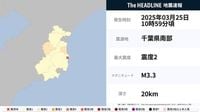On March 25, 2025, at 10:59 AM, a magnitude 3.3 earthquake was recorded in southern Chiba Prefecture, Japan. The earthquake was notable not just for its magnitude but also for its reach, which impacted several towns and cities.
The Japan Meteorological Agency announced that places experiencing significant shaking recorded a maximum seismic intensity of 2. More specifically, towns such as Ichinomiya and Chonan reported this level of intensity, indicating noticeable tremors that might have startled locals.
In addition to these areas, several cities observed lower levels of seismic activity. Among them, a seismic intensity of 1 was noted in Mobara City, Katsuura City, Isumi City, Oamishirasato City, Mutsuzawa Town, Chosei Village, and Otaki Town.
The earthquake's epicenter was located approximately 20 kilometers below the surface, a common characteristic for tectonic activity in this region. Fortunately, the earthquake did not pose a tsunami risk. The Japan Meteorological Agency confirmed this, stating, "There is no risk of a tsunami from this earthquake." This announcement would certainly have brought some relief to residents who may have feared secondary disasters following the tremor.
The seismic activity in Chiba Prefecture is not entirely unexpected. Japan's geographical landscape is well-known for its frequent earthquakes due to the movement of tectonic plates. Even minor quakes like this 3.3 magnitude shake serve as a reminder of the country's vulnerability to natural disasters, along with the importance of preparedness and awareness among the population.
Although there were no immediate reports of damage or injuries following the earthquake, the event has prompted conversations about building safety and emergency readiness in the region. Communities that experience seismic incidents are often encouraged to engage in disaster drills and awareness campaigns to ensure residents are prepared should a more significant earthquake occur.
Local government and community leaders may regard this occasion not merely as a concern but as an opportunity to review and enhance safety practices regarding earthquake preparedness. Understanding the risks associated with living in a seismic zone can aid not just in personal safety practices but also in effective community planning and infrastructure development.
Seismologists continuously monitor activity in areas like Chiba with the intention of better understanding patterns and preparing for larger events in the future. Such monitoring helps not just in immediate response but plays a role in the longer-term study of earthquake behavior in Japan.
As this earthquake demonstrates, even those registering on the lower end of the seismic scale can serve as awakenings to the potential threats posed by nature. Awareness and preparedness are crucial elements in living in a region marked by such geological uncertainty, and events like this highlight the importance of these proactive measures.
In conclusion, while the March 25 quake might have seemed minor in scope, its implications are significant. They are a wake-up call for both local authorities and citizens to prioritize earthquake safety measures, ensuring readiness for any future seismic events, no matter the scale.





